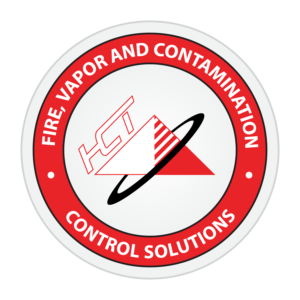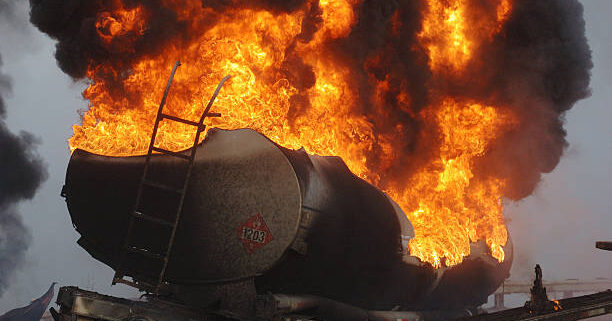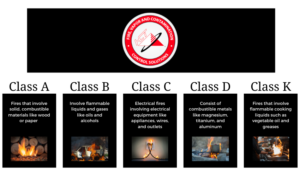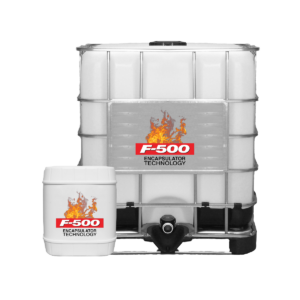Understanding different types of fires is essential for ensuring fire protection in both residential and industrial settings. One of the most common categories of fires is the Class B fire. Although this type of fire is common, many people are unsure of what a Class B fire truly is, how it differs from other fire classes, and how to extinguish it correctly.
At Hazard Control Technologies, we have years of expertise in fire suppression, offering products and services that meet the highest industry standards. As an ISO 9001 registered company, we always ensure that each product undergoes rigorous testing and quality control. When it comes to fire safety, you can trust HCT to provide the most reliable information and solutions for you.
Describing a Class B Fire
A Class B fire is described by the presence of flammable or combustible liquids and gases. In comparison to Class A fires, which are fueled by ordinary combustible materials like wood or paper, Class B fires generally involve materials like gas, alcohol, and petroleum greases. These flammable and combustible liquids have a lower ignition temperature, which makes them more susceptible to catching fire.
How Class B Fires Differ from Other Fire Classes
It is important to understand how Class B fires differ from other fire classes in order to perform effective fire suppression. Using the wrong fire suppression method could be very dangerous, so accurate identification is critical. The following are comparisons between other fire classes:
- Class A fires: involve solid materials like wood and paper
- Class B fires: involve flammable liquids and gases such as oils and alcohols
- Class C fires: electrical fires that involve energized electrical equipment
- Class D fires: consist of combustible metals like magnesium or titanium
- Class K fires: often encountered in restaurant settings, these fires pertain to cooking oils
Causes of Class B Fires
One way to prevent Class B fires is to understand their common causes. These fires are frequently seen in environments like chemical storage facilities, fuel transfer stations, and places where flammable liquids are stored. Some of the more frequent causes of Class B fires are mentioned below:
- Petroleum-based products like gasoline and diesel
- Alcohol and alcohol-based solutions
- Oil-based paints
- Flammable gases like propane and butane
- Lithium-ion batteries
The Science Behind Class B Fires
The Tetrahedron: Fuel, Oxygen, Heat, and Chemical Reaction
At the heart of any fire is what experts refer to as the “four legs of the tetrahedron.” The tetrahedron includes four key elements: a fuel source, an oxygen supply, heat, and an ignition source like a chemical reaction. In the case of a Class B fire, the fuel source is usually a flammable liquid or gas. Oxygen comes from the surrounding air, and the ignition source can be something like an open flame or a spark that creates a chemical reaction to start the fire. The interruption of one of these elements can extinguish the fire, which is the overall goal of fire suppression techniques.
Chemical Reactions in a Class B Fire
When a Class B fire starts, a chemical reaction occurs that sustains the fire. The flammable liquid or gas reacts with the oxygen in the air to produce heat, light, and by-products like carbon dioxide and water vapor. The heat that’s generated accelerates the chemical reaction, leading to a chain effect that continues until the fire is suppressed or the fuel is exhausted.
Flame Spread
In Class B fires, the term “flame spread” is a big concern. Because flammable liquids and gases have lower ignition temperatures, they spread rapidly once ignited. The rate at which the flame spreads depends on a few factors, including the type of fuel, its temperature, and the surrounding conditions. Effective suppression techniques often focus on slowing or completely stopping this flame spread.
Different Liquids, Different Risks
Not all flammable and combustible liquids pose the same risk. For example, petroleum greases and oil-based paints have unique characteristics that make them more difficult to manage. Their volatility and ease of spreading make them particularly dangerous in Class B fires. Knowing the specific liquid or gas you’re dealing with can significantly impact how you approach fire suppression.
How to Extinguish a Class B Fire Safely
Understanding what constitutes a Class B fire, its various causes, and the science behind it helps to prepare you for extinguishing this type of fire safely. With the knowledge gained in this blog, you’ll be equipped to react effectively in the event of a Class B fire.
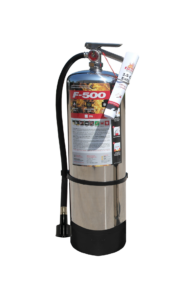 Types of Fire Extinguishers for Class B Fires
Types of Fire Extinguishers for Class B Fires
Traditional Class B foam extinguishers create a blanket, separating fuel from oxygen on a mechanical level. Our multi-class F-500 EA fire extinguishers separate fuel from oxygen on a molecular level, providing not only immediate fire knockdown but also a vapor-sealing feature to prevent re-ignition: encapsulation. Rigorously tested and backed by our ISO 9001 certification, they are the optimal choice for both efficacy and environmental responsibility. Unlike traditional extinguishers, which may require complex cleanup or present environmental challenges, our products offer hassle-free, eco-friendly solutions. Our stand-out solutions are an important aspect of our excellent range of fire safety products, which are suitable for diverse environments from industrial settings to potential workplace fires.
Other Types of Class B Fire Extinguishers
Different classes of fires require different types of fire extinguishers. With Class B fires, our multi-class F-500 EA fire extinguishers at HCT stand out the most, but the following are additional types:
- Carbon Dioxide Extinguishers: Remove the oxygen supply from the fire triangle, but are limited to smaller, less intense fires and don’t offer cooling to prevent re-ignition.
- Dry Chemical Extinguishers: Interrupt the chemical reaction of the fire triangle by creating a barrier between the fuel and the oxygen supply. They are widely used for Class A, Class B, and Class C fires, but can be corrosive and problematic.
- Foam Fire Extinguishers: Form a foam blanket on the surface of the flammable liquid. They cut off the oxygen supply to prevent future flames, but are potentially messy and require careful disposal.
- Dry Powder Extinguishers: More suitable for metal fires like Class D fires and are not as versatile.
Our multi-class F-500 EA fire extinguishers have been tested and approved for maximum performance and success, ensuring not only immediate fire knockdown but also a vapor-sealing feature to prevent re-ignition. Rigorously tested and backed by our ISO 9001 certification, they are the optimal choice for both efficacy and environmental responsibility. Unlike traditional extinguishers, which may require complex cleanup or present environmental challenges, our products offer hassle-free, eco-friendly solutions. Our stand-out solutions are an important aspect of our excellent range of fire safety products, which are suitable for diverse environments, from industrial settings to potential workplace fires.
Important Safety Precautions
When dealing with a Class B fire, always remember the following precautions: 1) Make sure that you are using the appropriate extinguisher. Using a water extinguisher can actually spread the fire instead of extinguishing it. 2) Keep a safe distance from the fire. We recommend at least 6 to 8 feet away when using a portable fire extinguisher. 3) Never use water because it can spread a flammable liquid fire, which makes the situation much worse.
For larger Class B fires, or if the fire continues to spread after using a fire extinguisher, it’s crucial to immediately call your local fire department. Evacuate the area and let professionals handle the fire.
It is important to understand the right tools and methods for extinguishing a Class B fire. Your knowledge and understanding can make a significant impact on minimizing damage from the fire and also ensuring the safety of everyone involved.
Best Practices for Class B Fires
While knowing how to extinguish a Class B fire is crucial, prevention is always a priority. Implementing preventative measures can significantly reduce the risk of a Class B fire ever occurring.
Safe Storage of Flammable Liquids and Gases
One of the primary causes of Class B fires is the improper storage of flammable and combustible liquids. These should be stored in well-ventilated areas far away from ignition sources. Utilizing safety containers and cabinets designed for flammable storage can also mitigate risks.
Proper Labeling
Clearly labeling all flammable and combustible materials is crucial for preventing Class B fires. In industrial settings, proper labeling can alert workers of the presence of hazardous materials, guiding them to take safety precautions.
Regular Inspection and Maintenance
Routine inspections of areas where flammable liquids are stored can help to discover potential hazards before they turn into actual fires. Maintenance work should involve checking the condition of containers and storage areas, as well as ensuring that all safety equipment, like fire extinguishers, is working correctly.
Technological Tools for Monitoring
Investing in state-of-the-art monitoring systems can provide real-time alerts in case of a fire hazard. These systems can detect unusual changes in temperature or the presence of flammable gases, which triggers immediate action to suppress the fire. With the implementation of these preventative measures and best practices, you will reduce the likelihood of a Class B fire ever occurring.
HCT’s Expertise in Fire Suppression
As we’ve explored, understanding the causes, suppression techniques, and prevention methods for Class B fires is important for both personal and workplace safety. To recap, here are the important points to remember: Class B fires are primarily fueled by flammable liquids and gases like oil-based paints and propane. The fire triangle (fuel, oxygen, and ignition) is crucial in both preventing and extinguishing these types of fires. There are different types of fire extinguishers that are effective for Class B fires, including carbon dioxide, dry chemicals, and foam. Lastly, preventative measures are an important aspect that includes safe storage, proper labeling, and regular inspections of the equipment.
Enhance With Hazard Control Technologies
For over 25 years, Hazard Control Technologies has been at the forefront of fire safety solutions. Our range of fire suppressant products and services are supported by cutting-edge research and comply with the highest quality standards. Our high-efficiency Class B fire extinguishers are tested to work effectively under various conditions. Additionally, our agent testing and consulting solutions can help you identify vulnerabilities in your fire safety protocols, and we offer educational programs to equip your team with the skills and knowledge required to handle different types of fire emergencies effectively.
Fire safety is not just about compliance; it’s about creating an environment where risks are minimized, and everyone is prepared for any emergency. At Hazard Control Technologies, we are here to provide you with adequate resources and ensure you’re taking an important step toward mitigating the risks of Class B fires. Contact us today to request a quote and begin your fire protection journey!
Resources:
- “ABCs of Fire Extinguishers.” The University of Texas at Austin. https://fireprevention.utexas.edu/firesafety/abcs-fire-extinguishers
- “Carbon Dioxide Extinguishers.” University of South Carolina. https://www.sc.edu/ehs/training/Fire/05_co2.htm
- “Classes of Fires.” UCLA Health. https://www.uclahealth.org/safety/ambulatory-safety/ambulatory-fire-and-life-safety-program/classes-fires-fire-extinguishers
- “Dry Chemical Extinguishers.” University of South Carolina. https://www.sc.edu/ehs/training/Fire/06_drychem.htm
- Hazard Control Technologies. https://hct-world.com/
- “The Fire Triangle.” University of South Carolina. https://www.sc.edu/ehs/training/Fire/01_triangle.htm
